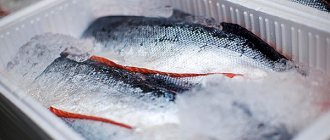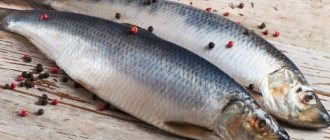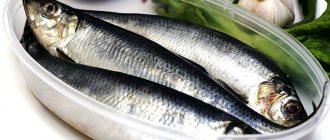How much and how to properly store fish: frozen, chilled and fresh
Every person who likes to eat fish and various fish dishes must know how to store fish, and what the shelf life of this product may be. After all, if you do not follow some rules, then there is a big risk of not only not enjoying a wonderful dish, but and get poisoned and end up in the hospital.
In the last article, we shared recipes and ways to quickly and easily prepare canned fish at home. This is one way to preserve fish at home.
And this article describes the simplest and simplest ways to store the product.
How to choose the right fish for consumption or for long-term storage?
Fish can be purchased in several types:
- Fresh. This is the best option to buy;
- Chilled. It also has pretty good taste;
- Frozen. This species can be purchased if the carcass was brought from afar;
- Thawed. It is better to refuse this purchase option, because it is unlikely that anyone will provide reliable information about how many times it was defrosted before.
In order to choose the best quality products, you should adhere to the following rules:
- The fish should have a pleasant smell, and the aroma of the sea is also quite acceptable;
- It is important to inspect the appearance: the scales should shine and fit tightly together;
- You need to examine the belly especially carefully - it should not be swollen;
- The fish's eyes should not be cloudy;
- The carcass should be dense and without marks on it when touched by hand;
- You should pay attention to the gills: they should be clean, free of various deposits, mucus and stains;
- It is recommended to make purchases in places where storage standards are observed;
- When purchasing packaged fish, you should pay attention to the expiration date;
- If the product was frozen, then you need to inspect it for damage to the skin and white spots - this is evidence of a low-quality product.
How to store fresh fish so that it does not spoil for a long time?
If you purchased fresh fish, the ideal option is to cook it immediately. However, this is not always possible.
Fresh fish cannot be stored at room temperature. It should be in the refrigerator. However, you shouldn’t just put the product in the refrigerator. Before this, the carcass must be washed well, gutted and dried - these actions will help maintain freshness.
It is recommended to store fish at a temperature of about minus two degrees, but all refrigerators are capable of maintaining this mode. In this case, there is one trick: before putting the fish in the refrigerator, you need to place it in a container with ice cubes.
Chilled fish can be stored for up to 72 hours if stored in the refrigerator. If you want to preserve the product for a longer period, you can salt it, smoke it, or prepare dried fish.
Storing whole fish
Whole fish includes:
- fresh or chilled;
- frozen;
- salted, smoked, dried.
It can be both sea and river fish. Let's look at the ways to store them.
In the freezer
Fresh or chilled fish is placed in the freezer compartment of the refrigerator if you do not plan to cook it immediately. An uneviscerated carcass needs to be prepared:
- cut off the fins and remove scales;
- gut;
- cut large carcasses into pieces;
- get wet from moisture;
- seal tightly in cling film or freezer bags.
The head of the carcass should be cut off if the product will be stored for more than 1-2 months. This part can be placed in a separate bag and frozen too. If the whole fish is sent to the chamber, then the gills must be removed.
The shelf life depends on the variety and ranges from 2 to 6 months at a temperature not exceeding -16 degrees. Fatty varieties, such as herring and mackerel, are stored the least. Pike, catfish, carp, cod, halibut, flounder - longer.
Store-bought frozen fish is also stored in the freezer. The shelf life in this case is determined by the manufacturer. If there are no instructions from the manufacturer, we rely on the deadlines indicated above.
There is no need to defrost and refreeze the product. Even after just one use it will go bad.
In the refrigerator compartment
If you plan to cook fresh or chilled fish in the coming days, you can not freeze it, but keep it in the refrigerator for a certain amount of time. To do this, the carcasses need to be processed in stages, as before freezing. At a temperature of +2 – +6 degrees it can be kept in the refrigerator for up to two days.
IMPORTANT! If fresh or chilled fish is stored at room temperature, do not delay cooking it for more than an hour. And in the hot season, do not store outside the cold at all. It quickly begins the process of bacterial growth.
Salted and smoked fish are also stored in the refrigerator:
| View | Shelf life |
| salty | lightly salted for up to 5 days, in a highly salted solution for up to 1 month |
| cold smoked | up to 10 days |
| hot smoked | 2 days |
ADVICE! Freezing processed fish is allowed, but there are some nuances. Smoked and salted fish will be less tasty after defrosting, and a hot smoked product will also lose its presentation.
If necessary, the freezing period is:
- up to 1 month for hot smoked fish;
- up to 2-2.5 months for cold smoked fish;
- up to 2 months for salted fish.
Dried fish contains the least amount of liquid, so can be stored outside the refrigerator in a cool, well-ventilated area. She can stay there for up to 1 month. In the refrigerator the product will last up to 3-6 months, in the freezer up to 1 year.
Proper storage of chicken breast, raw and cooked
How to properly store hot and cold smoked fish in the refrigerator
How long can raw and processed fish be stored in the refrigerator?
Any product, whether fresh or processed, must be packaged before being stored in the refrigerator. To do this, you can use parchment, cling film, foil or food vacuum bags.
Shelf life of frozen fish in the freezer
Most people choose to freeze unused fish to prevent it from spoiling. For this storage method, you should choose fresh, odorless carcasses. It is important to rinse the whole fish to remove any remaining water.
The product can be frozen either whole or in parts. After preparation, it is placed in a specialized thermal bag or vacuum packaging. To prevent the meat from drying out too much, you can leave the skin on when freezing. Also, after the carcasses are placed in the freezer, you can turn on the super freezing function on the refrigerator. This function helps you freeze food in a very short period of time without loss of quality.
The shelf life of frozen fish varies: meat can be stored in the freezer for three to six months. The period varies depending on how it was frozen. The main role here is not played by the variety; the temperature is much more important: it is necessary to strictly ensure that in the compartment where the fish is located it is always constant.
Freezing fish products in a home freezer
Housewives prepared fish pickles long before the advent of home refrigerators. As soon as freezing equipment appeared in the kitchen, freezing fresh or salted fish became the first way to store seafood. The home camera freezes fresh fish, salted herring or salmon, a whole carcass or cut-up pieces of gutted fish.
Fresh product freezing technology:
- Wipe the fish thoroughly with a wet towel and dry;
- gut, clean, wipe with vegetable oil;
- wrap in parchment paper and freeze for 20-30 minutes;
- transfer to a freezer shelf for permanent storage.
Each individual product will have to be processed and frozen separately. According to freezing and storage technology, you cannot put an unfrozen batch into the chamber in one pile.
Before freezing salted salmon and other representatives of red fish, whole fillets are cut into portions, wrapped in cling film, placed individually on a baking sheet and placed in a freezer to freeze the product. After “setting,” the workpieces are sent to the fish compartment for permanent storage.
Storing fish in the refrigerator
Particular attention should be paid to observing the shelf life of carcasses. Only a well-preserved product can bring true pleasure from eating it. It is important to put already prepared delicacies in the refrigerator, otherwise they may lose their freshness, taste and subsequently become unsuitable for consumption.
It is unacceptable to store fish in the freezer for storage again. If the meat has already been thawed, then it should be eaten, because during repeated storage, freezing will have a very strong and significant effect on the taste, nutritional properties, and, in principle, will make its further consumption simply unsafe.
For convenience, many people do not freeze the whole fish, but use it for minced meat. It is easier to store because it fits more compactly in the freezer.
Freezing to cleanse raw materials from parasites
Fish is loved not only by humans, but also by many helminths. The habitat of worms, the laying of eggs by the female, and the development of larvae become any part of the fish carcass - muscles, intestines, liver, head, gills. It even detects parasites in salted fish. When eating contaminated products, it is easy to pick up uninvited “guests” and then wage a grueling, not always successful fight against them for a long time.
Whether parasites in fish die when frozen directly depends on the timing and temperature of processing. Experiments with shock freezing of herring specimens infected with opisthorchids showed the following results:
- -40◦C – the parasites froze after 3 hours;
- -30◦C – the worms in the fish carcass died within 6 hours of freezing;
- -12◦C – product disinfection occurred after 20 days of temperature conditions;
- -3◦C – parasites are neutralized only after 30 days of freezing.
The size of the aquatic inhabitant is of decisive importance. The larger the individual, the longer and harder it needs to be frozen. Sterlet from the sturgeon family (red fish) is not colonized by parasites (it is no coincidence that the breed is considered noble).
How to prepare fish for long-term storage at home (video)?
Almost anyone can catch fish or buy it in a store. But preserving it for a long time is a whole science. This video shows how to store fish. Its further processing and preparation after salting.
How to properly defrost fish during long-term storage
Storing fish in the freezer is not such a difficult matter; after freezing, it is much more important to defrost it correctly and without errors. Many people in theory understand what needs to be done and how, but in reality it turns out that not everything is as simple as it initially seemed.
Often the fish is simply placed in a container with cool water, and then they wait patiently for it to melt. In fact, this is not entirely true. With this method, the meat loses most of its nutrients, the taste becomes worse, and the structure becomes soft.
How to freeze fish
BellaRussa — Oct 24th, 2021 Categories: Freezing, Fish for future use
Tags: Freezing fish
It is not difficult to refreeze frozen sea fish bought in a store. If it didn’t have time to melt much while you were taking it home, then quickly pack it in a ziplock bag and put it in the freezer. More problems arise with storing river fish, especially if your spouse is a fisherman.
Ingredients: fish Time to add: All year
There are several options for freezing river and sea fish too. You can freeze the fish as is. That is, don’t clean it at all, but simply wash off the mud and algae, lay it out on a tray and freeze it individually. Then put them into bags when each fish is frozen enough so that they do not freeze in the bag into one ice lump. This method is good for small fish. You can store it for about a month until you figure out what to do with such a little thing.
If the fish is larger, it is better to clean it from scales and gut it. This way it can be stored longer, and subsequent defrosting and cooking will go faster. If the fish is very large, it is better to cut it into pieces.
Often, food, and in particular fish, in the freezer becomes covered with a white coating with an unpleasant odor. This is chapping. When frozen, ice crystals squeeze fish oil out, and frequent opening and closing of the freezer leads to temperature changes and, accordingly, the spoiling of this fat.
To avoid chapping, fish can be frozen in a “glaze”. When we see “icing” on products in the supermarket, we get a little angry because we have to pay extra for the ice. But what can you do if this is the most effective method to preserve fish.
You don’t have to sell or buy fish, and if you’re not worried about the beauty, but only about the safety of the fish, you can freeze it directly with an ice block. Cut large fish into pieces so that each piece fits in a ziplock bag, and pour a little cold water into each bag. Then, try to zip the bag, leaving as little air in there as possible.
If you want only a thick ice crust to appear on your fish, like in the store, you will have to spend a little more time.
Immerse the fish carcasses in very cold water for a minute, then shake them off a little, place them on a tray, away from each other, and set the freezer to maximum frost. This is a blast freeze and will help create that icy glaze. Then put the frozen fish carcasses in bags, and you don’t have to worry about their safety for at least 6 months.
How to freeze fish, watch the video:
Tweet
Features and shelf life of chilled fish
The best possible option is to purchase the product in such quantity that it can be prepared immediately.
But situations are different, so it’s better to know how to store fresh fish. Shelf life differs for each type: smoked, salted, fresh, minced, whole carcass or caviar. For example, chilled fish has a shelf life of no more than three days - and the temperature in the refrigerator must be maintained from -2°C to 0°C. In ordinary refrigerators the temperature is 5-6°C, so the storage duration is reduced to a day.
But there are other options to delay the spoilage of the product: freezing, salting, smoking, canning and drying. Whatever method you choose to store fresh fish in the refrigerator, remember that it should be placed as far as possible from other products. Otherwise, other products will absorb the smell of fish, and the fish will absorb their smell. This is especially true for dairy and meat products.
Preparation for storage
The rules for storing fish include a preliminary preparation stage. The algorithm is quite simple:
- Raw fish must be scaled and giblets removed.
- Wash top and inside, dry with napkins or paper towel.
- If you are going to store the product for about two days, then you need to sprinkle with salt or sprinkle with lemon juice.
- Transfer the fish to a storage container, wrap it with cling film or close it tightly with a lid.
There is no need to wash finished fish fillets before storing them in the refrigerator.
There are ways to preserve fresh fish without refrigeration, invented by our ancestors at a time when no one dreamed of this technological miracle. In order for fresh fish to last 2-3 days, you need a cool and well-ventilated room. You need to do the following:
- clean from scales, gills, entrails, fins;
- wipe dry with a towel;
- rub the carcass on all sides with spices (usually salt and ground black pepper are used);
- wrap the fish in cotton cloth soaked in a solution (200 ml of vinegar and 2 teaspoons of sugar);
- Cover the inside and outside with coarse salt.
If you plan to freeze the carcass, then you need to put it in a plastic bag. It is recommended to divide a large specimen into small portions.
Optimal conditions
Raw fish cannot be kept in a refrigerator at above-zero temperatures, as this product is subject to rapid spoilage due to the development of bacteria and moldy fungi. They begin to multiply within a couple of hours after the temperature rises and lead to rotting.
Fish, if properly prepared, has a shelf life in the refrigerator of 1-3 days. At the same time, raw minced meat, cutlets or fish pieces can be stored for only 10 hours, and fillets for 24 hours. In the freezer, where the temperature reaches -24°C, fish can last from 3 to 6 months, depending on the fat content.
Temperature
The ideal storage temperature is from -2°C to 0°C. With this mode, the fish will be preserved for three days. Unfortunately, most often the temperature in refrigerators is 5-6°C, so the period is reduced to just one day.
If there is no temperature-controlled zone in the refrigerator, you can make one yourself using a container with ice and store the fish there. With this method, you need to constantly monitor the condition of the ice so that it does not melt. If this suddenly happens and the carcasses end up in water, they will spoil very quickly.
Frozen food storage
The temperature regime for storing dry frozen products is standardized by GOST 1168-86:
- ship storage facilities, distribution refrigerators -18◦C;
- freezers of commercial enterprises - no higher than -5-6◦C, and such a product must be sold within 14 days maximum.
The prepared batch is sent for storage in special containers: wooden boxes, cardboard boxes, barrels, matting bales.
The bottom is lined with wrapping paper. If the variety can be stored in rows during storage, each layer is also covered with wrapping protection. Particularly valuable varieties (red fish, white fish) are wrapped individually in parchment for long-term storage. Return to list
Useful tips
Fish is a frequent guest on the table in many homes, but since it is a perishable product, it is very important to remember the rules and terms of its storage.
Otherwise you can get poisoned.
- If it is not possible to put the fish in the refrigerator, then you can use regular sunflower oil: clean the carcass of scales and intestines, and then grease it with oil. In this state, the shelf life of fish is several days due to the oil film, which stops the development of bacteria.
- Another alternative storage method is pickling. The fish must first be salted and then sprinkled with lemon juice. This will not only extend the shelf life, but will also make the taste juicier and the meat more tender.
- Only fish that thaws gradually is able to retain its taste and beneficial properties. Therefore, a frozen product cannot be defrosted quickly - transfer the fish from the freezer to the lower chamber of the refrigerator and only then onto the table. You should not try to speed up the process with hot water or a microwave - this will spoil the taste and destroy the structure of the meat.
- Thawed fish must be cooked immediately - you should never store it in the refrigerator for more than a day! Otherwise, there is a huge risk of bacteria and product spoilage.
- Do not store fish in a refrigerator bag - this will reduce the already short shelf life to 8-12 hours. This bag can only be used to transport groceries.
- Heat treatment increases shelf life, but not by much. According to GOST, fried fish dishes can be stored no longer than 48 hours after preparation. The same applies to hot smoked fish.
Storing fresh fish
The most delicious is fresh, recently caught fish. If you bought crucian carp, carp or silver carp, then try to cook them as quickly as possible. The same applies to catches made with your own hands. But if there is a hitch with the cooking, then you should take care of storage. Fresh fish should be stored without entrails at a temperature of 0...+3 °C, in the refrigerator.
- First, it is gutted and cleaned.
- Then they wash it inside and out, wipe it with a napkin or towel to remove excess moisture.
- Place in the refrigerator in a bowl covered with cling film or in another container with a lid.
- You can sprinkle with salt if you are going to store for 2 days. Lemon juice is used instead of salt. This causes the fish meat to be slightly marinated and become more tender.
The maximum shelf life is 2 days, but it’s better not to wait until the last minute and not take risks. If you want to store fish for more than 2 days, freeze it by wrapping it in a plastic bag. You can also freeze unpeeled fish. This saves housewives who do not have the strength to process the entire catch at one time. Fresh fish can be kept in the freezer for several months. It must be defrosted gradually, without haste, without using hot water or additional heating. Re-freezing is prohibited, since the taste of the product deteriorates and spoilage is possible.
Do not store unpeeled fish and fillets together in the refrigerator. Bacteria from the untreated product will transfer to the fillet, thereby accelerating its deterioration. It is also not recommended to place fish near dairy products, as they quickly absorb the smell.
Freezing and storing fish
A lucky fisherman can catch so many fish that it would be impossible to cook and eat at once. Freezing fish is a good way to preserve your catch, both whole fish and fillets. Only fresh fish can be frozen. It is best to store fish in the freezer. Raw fish does not need to be salted before freezing. Salt does not increase the shelf life of frozen fish, but it greatly affects the taste of the fish and its texture after defrosting, not for the better.
It is advisable to freeze fish in packaging (bag, plastic container, foil). The package must be tightly closed. The less access a product has to oxygen, the longer it is stored. Sometimes fish are frozen in an ice cube. To do this, you need to put the fish in a bag and then place it in a container of water that can be frozen.
Low-fat fish, such as pike, last longer when frozen than high-fat fish, such as trout. However, frozen herring or flounder retain their flavor for about a year, while pike and perch begin to lose their flavor after about six months of being frozen.
Smoked fish
If the fish has been cold smoked for a long time, it can be stored in the refrigerator for 10 days, wrapped in paper. Hot smoked fish can be stored in the refrigerator for only 3 days. This difference in timing is due to the fact that during cold smoking the carcasses are more saturated with salt and undergo heat treatment for a longer time.
Both types of smoked fish can be frozen. They will keep quietly in the freezer for 3 months. If you do not want to freeze, then wrap it in a cloth soaked in salt water. In this form, it will lie at a temperature of +3 °C for about a month.
Smoked fish balyk can be stored in the refrigerator for no more than a week, and if you cut it into pieces, you will have to eat it within 3 days. Be sure to ensure that mold does not appear on the meat and pay attention to the smell.
Salted and dried fish
Many people like to eat dried fish: roach, rudd, perch, sabrefish, bream and others. Let's find out how long it can be stored and under what conditions. It is stored for a long time, since salt acts as a preservative. If the fish has been dried well, then with proper storage it can last for a year. It should be wrapped in thick wrapping paper and kept in a dry, cool and dark place.
Previously, fish were often wrapped in newspaper, without thinking about the fact that printing ink contained lead. If you categorically reject newspaper, you can use craft paper, parchment, or a tin or glass jar with a lid. Dried and dried fish are stored in cardboard boxes, wicker baskets, and linen bags.
For those who live in hot climates, we recommend placing any fish in the freezer. This is the only way it can be stored for a long time.
Now let's talk about salted fish. Many housewives buy fresh or frozen product, making home salting, but you can also find a variety of varieties of salted fish on store shelves. If you store fish in brine (brine, as experts say), the shelf life increases. The amount of salt used during preparation is also of great importance.
| Product type | How long to store in the refrigerator, at a temperature of 0...+3°C, days |
| Homemade lightly salted salmon | 2–3 |
| Vacuum packed salmon | 30 |
| Herring in brine | 15–30 (depending on the degree of salinity) |
| Specially salted fatty mackerel | 10 |
Strongly salted fish can be kept in the refrigerator for a month without freezing, medium salted and marinated fish - up to 15 days, lightly salted fish - no more than 6 days.
Pieces of salted herring, salmon, and salmon can be stored in the refrigerator for almost 3 months if they are covered with vegetable oil.
Carp
Product Description
At the risk of causing ridicule from fishermen, let's say that a fish named carp does not exist in nature. Only in fishing and on store shelves. Scientists once identified a whole family of carp , which includes many fish - from crucian carp to roach, but carp is not there in the list of natural fish species of this family. The thing is that “carp” is the common and trade name for the domesticated carp . From the point of view of biologists, this is Cyprinus carpio carpio, and the repetition of the second word is not accidental: it turns out “carp sazanovich”, “carp’s son”, cultural carp.
Cultivated carp, that is, carp, has very tasty, tender, slightly sweet meat. The average weight of carp is 2-2.5 kilograms, although there are unique specimens weighing up to 35 kilograms.
The homeland of this fish is China. In the Middle Kingdom, carp were bred in ancient times, and carp dishes have always been considered a delicacy worthy of an emperor. The carp was brought to Europe only in the 12th century, but today it lives in fresh waters all over the world, with the possible exception of South America, Australia and the island of Madagascar.
As a result of long-term selection, several types of carp were born, which differ not in meat, but, first of all, in scales.
Types and varieties
As a result of long-term selection, several types of carp were born, which differ not in meat, but, first of all, in scales. Scaly carp have scales that evenly cover the body. The mirror carp is covered with shiny golden scales (), but, as a rule, only half. Frame carp retains scales only on its back and belly. There are also naked carp, scaleless.
How to cook
Carp have very tasty, tender, slightly sweet meat, but there are a lot of small bones.
If you are going to make minced fish, you can grind the carp meat along with the bones - they will not be felt. If you are going to fry the carp, cut the fish along the entire length from the back and fry in hot oil - the bones will become much softer, and the small ones will seem to dissolve.
Carp dishes are found in the cuisines of various countries. In China, carp is very popular. In China, carp is boiled, fried, baked with vegetables, and cooked in sweet and sour sauce. In Bulgaria, carp is stuffed with nuts, fried with bacon, baked and pickled. On the menu of German and Polish restaurants you can find carp stewed in beer, and in Hungary they cook carp with smoked lard and paprika. In France, carp is stuffed with minced fish and mushrooms and stewed in red wine. This dish is called carp a la Chambord.
Season
The best time for carp fishing is summer . Carp is a very heat-loving fish, which becomes more active as the water warms. Summer carp fishing begins in early June , when spawning ends, and continues with short breaks until September .
Carp is caught in the spring , after the ice disappears, when the carp begins to gain weight and then goes to spawn, and in the fall - despite the fact that in September-October, the activity of the carp noticeably decreases (although on relatively warm and bright days it eats off for the winter).
about winter carp fishing . In fact, carp can go without food for up to a month, so they lose weight and do not bite too actively. However, during periods of thaw and during daylight hours, the behavior of carp changes.
How to select and store
Fresh carp should only smell like water. The fish's eye should not be cloudy.
The gills of the carp should be red-pink: not cloudy, not blue, not green. Pink gills are a sign that the fish is fresh and recently caught.
Determine how resilient the carp is. If, when pressing on the carp, no trace remains, the fish is fresh.
The carp's tail should lie flat. If it is bent, then the fish is old and dried out.
store carp in the refrigerator for up to 3 days. Before storing carp, it is better to clean, gut, and remove the gills; After this, the fish carcass should be placed in a glass container and covered with cling film.
in the freezer for up to 2-3 months.
Ready-made fish dishes
If the fish has been heat-treated, it can be stored outside the refrigerator for some time. This is what usually happens when fried, baked or stewed fish is put on the table. However, after being in warm conditions for 2-3 hours, it should be placed in the refrigerator. There, at a temperature of +2°...+3°C, it can stay for 2 days.
Special sushi cases are used to store sushi and other fish dishes with rice. At home, uncut sushi can be stored for 24 hours. If you order a dish to take home and don’t finish it, throw away the leftovers. In general, you can only eat fish dishes that have not undergone heat treatment if you are confident in their quality.
Storing fish dishes
We will separately consider the rules for storing dishes prepared from fish. It could be:
- boiled, baked, fried fish;
- fish steaks, cutlets, sticks;
- salads, soups, baked goods with fish.
NOTE! The recommendations apply to dishes prepared at home. Semi-finished products and ready-made dishes from meat, fish, potatoes and other ingredients purchased in stores and public catering establishments are labeled with storage conditions and expiration dates. They must be adhered to.
In the freezer
Semi-finished fish dishes, such as homemade dumplings, minced meat, raw cutlets, and meatballs, are placed in the freezer. You should not keep them frozen for too long: no more than one month. The exact period depends on the temperature in the chamber: the lower it is, the longer the product is stored.
Such a short period is due to the fact that self-prepared semi-finished products differ from purchased ones. They do not contain preservative additives, which are added during production to increase shelf life. Defrosting and re-freezing of products is not recommended.
In the refrigerator compartment
Freshly prepared fish dishes are stored in the refrigerator after cooling. The timing depends on the type of dish:
| Name of dish | Shelf life |
| Fish soups, broths | Up to 24 hours |
| Second courses | Up to 24 hours |
| Fish pies, baked goods | Up to 48 hours |
| Fish salads seasoned with sour cream, mayonnaise, yogurt/vegetable oil/without dressing | Up to 12/18/24 hours |
How to store carp in the refrigerator
Fresh fish and seafood not only taste great, but also have great health benefits. If you are interested in how to store fish so that it remains fresh longer than after the catch, then when buying it you need to pay attention to its appearance and smell. While the old German saying is true: “The oven is the best place for freshly caught fish,” there will be times when you will need to store it or seafood for several days before cooking.
How to store fish correctly?
Since fish has an exquisite taste and is very healthy, it is not surprising that nutritionists recommend eating it at least once a week. However, fish will not retain its freshness if it is stored in a regular refrigerator. We are pleased to inform you that Liebherr refrigerators have all the conditions for the best possible storage of fish.
Let's look at a few important rules on how to properly store fresh fish.
Pay attention to the freshness of fish when purchasing
The fresher the fish you buy, the longer it can be stored. So, how can you tell if fish is fresh or not? When purchasing, follow our tips below.
- The fish should have a faint odor, in most cases the aroma of the sea or iodine. Stale fish has an unpleasant odor.
- Shiny, firm and elastic scales are a sign of fresh fish.
- Fresh fish have open, protruding, bright and translucent eyes. Dull and gray eyes are characteristic of stale fish.
- The gills should be light and shiny. Yellow and brown shades characterize stale fish.
- If possible, use your index finger to press firmly onto the scales of the fish. Fresh fish will be firm and elastic, and there will be no mark left on the scales after pressing. Flat fish should not lose their shape when you pick them up.
- Ideally, the seller stores the fish in a container with ice, rather than on ice, to keep it cooler.











